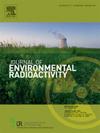Developing a machine learning-based predictive model for cesium sorption distribution coefficient on crushed granite
IF 1.9
3区 环境科学与生态学
Q3 ENVIRONMENTAL SCIENCES
引用次数: 0
Abstract
The sorption of radionuclides on granite has been extensively studied over the past few decades due to its significance in the safety assessment of geological disposal for high-level radioactive waste (HLW). The sorption properties of granite for radionuclides exhibit considerable variability under different experimental conditions. To reduce the time and cost associated with traditional experiments, this study developed a data-driven approach utilizing machine learning (ML) algorithms to predict the sorption distribution coefficients of cesium (Cs) on crushed granite efficiently. Four ML algorithms, namely AdaBoost, GBDT, LightGBM, and XGBoost, were employed to construct predictive models using a dataset of 384 data points. All models demonstrated strong performance, with R2 values exceeding 0.8 for both the training and test sets. Comparative analysis of evaluation metrics indicated that the XGBoost model exhibited the best predictive performance and generalization ability. An explanation analysis of the XGBoost model further revealed the importance and influence of each input feature in predicting the distribution coefficient of Cs on crushed granite. The features affecting radionuclide sorption on granite were ranked by importance as follows: solid/liquid ratio, ion strength, pH, contact time, initial concentration, and maximum particle size. The underlying sorption mechanisms by which different input features affect the sorption coefficient, as derived from shapley additive explanations (SHAP) analysis, correspond with experimental observations. The approach proposed in this study can serve as a supplement to resource-intensive experimental methods, providing new insights into predicting the sorption behavior of radionuclides on crushed granite for the safety assessment of HLW geological disposal.
基于机器学习的花岗岩碎块铯吸附分布系数预测模型研究
由于放射性核素在花岗岩上的吸附在高放废物地质处置安全性评价中的重要意义,在过去的几十年里,人们对其进行了广泛的研究。花岗岩对放射性核素的吸附特性在不同的实验条件下表现出相当大的变化。为了减少与传统实验相关的时间和成本,本研究开发了一种数据驱动的方法,利用机器学习(ML)算法有效地预测铯(Cs)在破碎花岗岩上的吸附分布系数。采用AdaBoost、GBDT、LightGBM、XGBoost四种ML算法构建384个数据点的预测模型。所有模型均表现出较强的性能,训练集和测试集的R2值均超过0.8。评价指标对比分析表明,XGBoost模型具有最佳的预测性能和泛化能力。通过对XGBoost模型的解释分析,进一步揭示了各输入特征对预测破碎花岗岩上Cs分布系数的重要性和影响。影响花岗岩对放射性核素吸附的重要因素依次为固液比、离子强度、pH、接触时间、初始浓度和最大粒径。从shapley加性解释(SHAP)分析中得出的不同输入特征影响吸收系数的潜在吸收机制与实验观察相一致。该方法可作为资源密集型实验方法的补充,为预测高放射性废物地质处置安全性评价提供新的思路。
本文章由计算机程序翻译,如有差异,请以英文原文为准。
求助全文
约1分钟内获得全文
求助全文
来源期刊

Journal of environmental radioactivity
环境科学-环境科学
CiteScore
4.70
自引率
13.00%
发文量
209
审稿时长
73 days
期刊介绍:
The Journal of Environmental Radioactivity provides a coherent international forum for publication of original research or review papers on any aspect of the occurrence of radioactivity in natural systems.
Relevant subject areas range from applications of environmental radionuclides as mechanistic or timescale tracers of natural processes to assessments of the radioecological or radiological effects of ambient radioactivity. Papers deal with naturally occurring nuclides or with those created and released by man through nuclear weapons manufacture and testing, energy production, fuel-cycle technology, etc. Reports on radioactivity in the oceans, sediments, rivers, lakes, groundwaters, soils, atmosphere and all divisions of the biosphere are welcomed, but these should not simply be of a monitoring nature unless the data are particularly innovative.
 求助内容:
求助内容: 应助结果提醒方式:
应助结果提醒方式:


